What is a side-address microphone? What is the best side-address microphone? How you can use one to get the best sound for your recordings?
Don’t worry, we’ve got you covered. In this article, we’ll answer all these questions and more.
What is “side-address”?
“Side-address” is a term used to describe a microphone and the position of its capsule or diaphragm. Side-address microphones capture sound through the side, rather than the top or end – hence the term “side-address”.
The placement of the capsule dictates what type of “address” a microphone has.
When you think “address”, think of the part of the mic you need to speak into, or where you need to direct the sound source from. 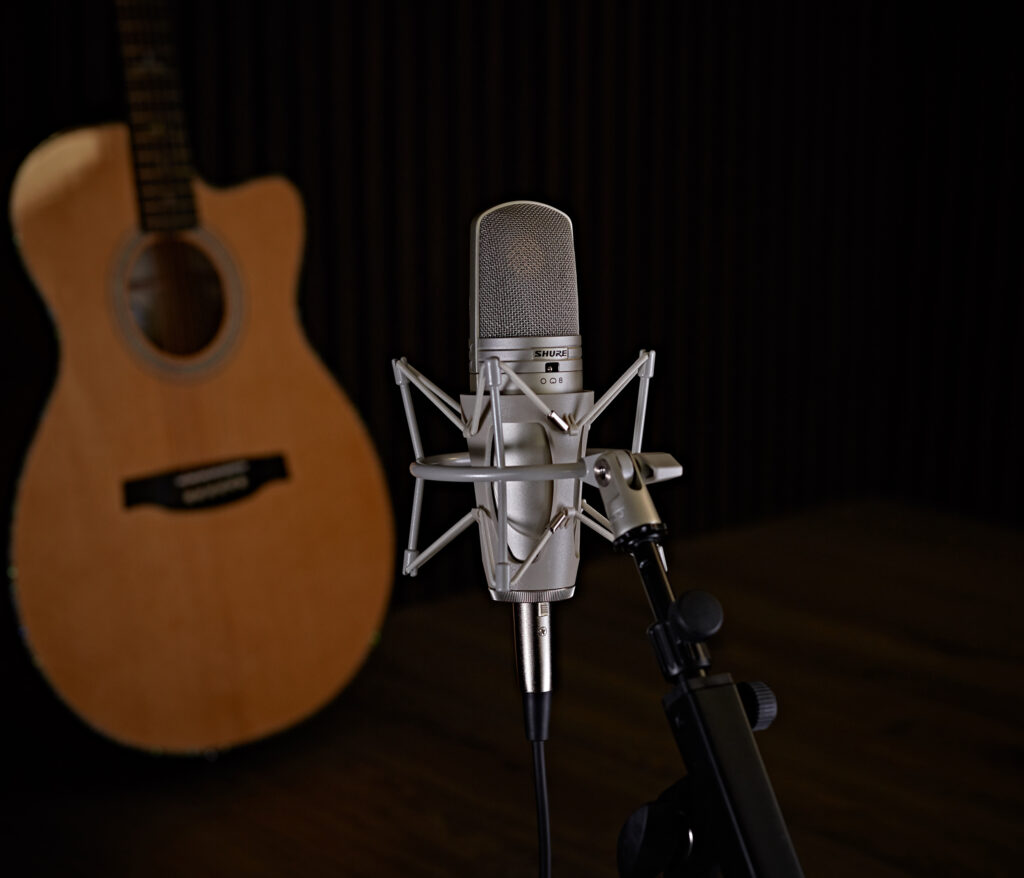
What is a side-address microphone?
A side-address microphone, like the Shure KSM32 Condenser Microphone, is a microphone where the recording capsule is placed at the side.
Unlike directional microphones, which will have you point the top of the microphone towards the sound source, a side-address microphone will require you to direct the sound source towards the side.
If you’re singing, you point the microphone directly towards the ceiling and sing towards the side of it. If you’re recording a guitar, you place the side of the mic towards the sound source.
Are all microphones side-address?
No. Side-address microphones are usually condenser and ribbon microphones, whereas top-address microphones are often dynamic microphones, such as the Shure Sm58.
A quick way to find out whether your microphone is a side-address is to locate where you need to send the sound signal. Does the mic capture the sound at the top or end? If so, it’s a top-address. If you have to sing to the side, it’s a side-address.
Side address microphones are usually placed on a stand or cradle, and you don’t hold them when you record.
If you can hold it when you record – it’s probably not a side-address microphone!
What is a side-address microphone used for?
Side-address microphones are predominantly used to capture audio that is stationary. Basically, anything that doesn’t move. They are used to record vocals, speech, guitar amps, drums, guitar amp cabs and other sound sources.
These kinds of mics will almost always use a cardioid polar pattern as this ensures you capture all the subtle nuances of your sound source whilst rejecting anything around or behind it.
To put it simply, if you’re recording vocals with a side-address mic, you won’t hear a clock or door shut behind the microphone – the cardioid polar pattern only records what’s in front of it.
To better understand what side-address microphones are used for, you need to understand polar patterns. So, we recommend reading our Microphone Polar Patterns – Everything You Need To Know article.
What are the benefits of side-address microphones?
The key benefit of a side-address microphone is that you get a highly controlled sound recording with added nuances courtesy of a slightly wider recording surface. Again, we need to think about the cardioid polar pattern here, as you achieve this controlled sound through the cardioid polar pattern – which rejects unwanted background noise – and the stationary position of the mic.
As mentioned, almost all side-address condenser microphones are used in conjunction with a stand, and a cradle if recording vocals. These minimise knocks and bumps coming through into the recording. A good capsule will provide a rich, sonic quality, but it will also pick up any vibrations, bumps or physical knocks or hits unless used in conjunction with a cradle.
This is why condenser microphones and especially side-address condenser microphones aren’t used for live vocals – they’re not meant to move around.
However, they can be used – and are used extensively – in a live scenario! For sound engineers, side-address condenser microphones are extremely useful, especially when mic’ing up a guitar cab, brass instrument or drum. They capture the sound source but pick up very little of the other instruments around.
This means the sound engineer can mix the live band and isolate certain instruments, providing greater control.
If you’re a studio engineer, you’ll find side-address mics are incredibly important pieces of equipment, as they only capture the desired sound source and provide a far cleaner, precise recording to work with.
What can I record with side-address microphones?
Basically, anything that isn’t moving. Side-address microphones are used to capture a variety of sound sources including wind and brass instruments, drums, guitar cabs, acoustic guitars and, of course, studio vocal recordings.
Side-address condenser microphones are particularly sensitive. They’re designed to capture everything from the subtlest of guitar string nuances to the boldest saxophone note changes – but they can only achieve such quality when they’re placed in a stationary position.
If you’re wondering how to get the best guitar recordings possible, we’ve put together a handy guide on how to record your guitar – it’s worth reading if you’re just starting in the world of home studio recording.
What are some of the best side-address microphones?
There are plenty of different side-address microphones to suit a variety of budgets, but a few clear winners come to mind when deciding on the absolute best. Here are our top 5 best side-address condenser microphones, including options from Shure, AKG and Sennheiser.
1. The Shure KSM44A Large Dual Diaphragm Microphone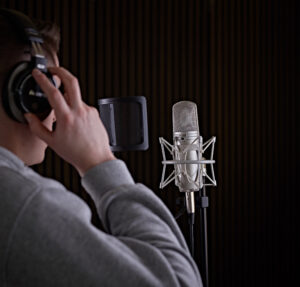
At the top of our list, we have the Shure KSM44A Large Dual Diaphragm Microphone. This is one of the best side-address condenser microphones on the planet right now, and it’s widely regarded as a great small to mid-size studio microphone that delivers near-perfect audio quality.
You have a dual-diaphragm design that ensures you capture every subtle nuance, every chord change, every string, and every quality of your instrument beautifully.
The 20Hz – 20kHz frequency response makes it a great choice for vocals, whether you’re screaming or whispering. The 15dB attenuation switch allows you to cut the input, which means it can be used for loud wind instruments as well as loud guitar cabs on stage or in the studio without fear of damaging the capsule.
One of the key benefits here comes in the form of the choice of three polar patterns which are selectable on the mic. The Bidirectional, Cardioid and Omnidirectional polar patterns make it a great room recording mic, especially useful for choirs, sound recording artists and podcasters too! it’s essentially 3 different mics in 1.
Did we mention it comes with a carry case, cradle and shock mount too? Say goodbye to those knocks and bumps making their way into your recordings!
Who is the Shure KSM44A Large Dual Diaphragm Microphone for?
- Pro recording artists
- Studio engineers
- Home studio recording enthusiasts
- Voiceover artists
- Dolby and foley sound effect recording artists
Shop now | Shure KSM44A Large Dual Diaphragm Microphone
2. Shure KSM32 Condenser Microphone
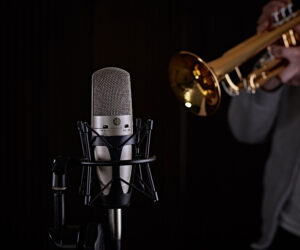 The Shure KSM32 Condenser Microphone is another condenser mic from the acclaimed Shure KSM range, providing streamlined functionality, on a lower yet reassuringly mid-level budget
The Shure KSM32 Condenser Microphone is another condenser mic from the acclaimed Shure KSM range, providing streamlined functionality, on a lower yet reassuringly mid-level budget
without sacrificing quality. If you want a high-quality side-address condenser microphone that provides exceptional sound quality this is a great option that won’t break the bank at under £500.
This is a high-performance highly transparent side-address condenser microphone that won’t colour your sound at all. You’ll hear everything you need to hear thanks to a 0.75” ultra-thin Mylar diaphragm.
You have Class-A transformerless preamp circuitry built-in, which eliminates cross-over distortion and the fact you can activate a switchable -15dB attenuator means you’re ready to record high SPL instruments like drums, brass, wind and louder guitar cabs. In fact, you’re covered up to 154dB which is perfect for recording in a studio when you need to open up some serious guitar amp sounds or record full brass ensembles.
Who is the Shure KSM32 Condenser Microphone for?
- Brass recording
- Wind recording
- Studio engineers
- Vocal recording
- Home studio enthusiasts with sub £500 budgets
3. AKG C214 Large Diaphragm Microphone
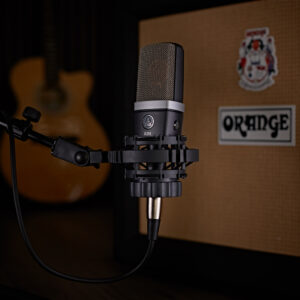 Next up we have the AKG C214 Large Diaphragm Microphone, which at just under £300 won’t blow any budgets.
Next up we have the AKG C214 Large Diaphragm Microphone, which at just under £300 won’t blow any budgets.
This is one of the best side-address condenser microphones owing to the fact you have an extended reduction in sound to work with. The 20dB pad, low-cut switch ensures you can record the loudest of instruments free of the worry that you’re going to damage the microphone or record with distortion. The cardioid polar pattern, 1″ Edge-Terminated large diaphragm and wide frequency range of 20 to 20000 Hz makes it great for louder instruments, especially in a live setting.
The dual capsule system also ensures you’re getting a highly detailed sonic quality, which ensures you can capture spoken word, recorded vocals and ambient sound in great detail.
Who is the AKG C214 Large Diaphragm Microphone for?
- Studio engineers
- Live PA sound engineers
- Drum recording artists
- Ambient recording artists
- Foley artists
- Travelling musicians
4. Shure Beta 181 Side Address Cardioid Condenser Microphone
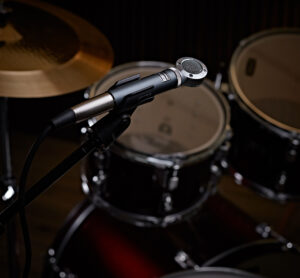 We can’t have a best side-address article without including the industry-standard Shure Beta 181 Side Address Cardioid Condenser Microphone!
We can’t have a best side-address article without including the industry-standard Shure Beta 181 Side Address Cardioid Condenser Microphone!
This legendary side-address condenser mic has been designed for tighter situations, owing to its smaller, almost pencil-like design. Perfect for drum overheads, acoustic piano recording and those situations that call for discreet placement such as television and studio recording or churches, the Shure Beta 181 Side Address may be small, but is ready to tackle the loudest of sound sources.
You have a 149 dB SPL to work with, so acoustic pianos and drum overheads aren’t a problem, whilst the 20 to 20,000 Hz ensures subtleties are captured beautifully. Acoustic instruments will sound clear at all times.
This is also built for the travelling musicians, sound engineers and those with portable studios as the steel grille won’t dent, it’s water-resistant and the housing is built like a tank –all owners will appreciate the hardy, rugged design.
You can also use these to record drums in stereo, and create an incredible live feel. Just be sure to place each Shure Beta 181 equidistance from your snare on the left and right of your kit or above the drummer angled side-on to capture the sound.
Who is the Shure Beta 181 Side Address Cardioid Condenser Microphone for?
- Studio owners
- Live sound engineers
- Drum recording artists
- Portable studio owners
- Drum technicians
5. Sennheiser MK4 Large Diaphragm, Side Address Mic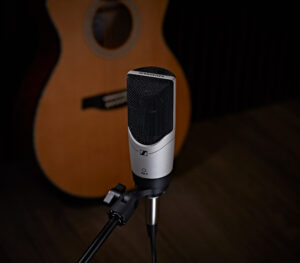
Last but not least we have the Sennheiser MK4 Large Diaphragm, Side Address Mic, which is our most budget-friendly option. This side-address condenser microphone makes our best-of list thanks to its focus on providing a warmer tone that vocalists will appreciate. Although this does provide an honest and accurate representation of the sonic recording, it will slightly colour your tone, providing a warmer sonic quality than most.
The 24-carat gold plated diaphragm is perfect for capturing the subtleties of vocal performances. It’s worth bearing in mind that the lower 140dB maximum SPL does potentially rule it out for the loudest of guitar cabs out there, but certainly ensures it’s one of the best acoustic guitar recording microphones available as a focus has been placed on providing exceptional clarity over (potentially) unneeded expanded functionality (LINK TO BEST ACOUSTIC GUITAR MICS).
The combination of a full-metal housing and built-in capsule shock mount means you’ll enjoy a noise-free recording experience making it ideal for vocalists, voiceover artists and recording engineers.
Tough, low price, high-quality construction. There’s not a lot to love about this side-address condenser microphone.
Who is the Sennheiser MK4 Large Diaphragm, Side Address Mic for?
- Acoustic recording artists
- Home studio enthusiasts
- Voiceover artists
- Podcasters
- Recording at lower volumes
Find out more
And that wraps up our complete guide to side-address microphones. Post a comment below and let us know if you think we’ve missed any awesome side-address condenser microphones or if you have any questions on the key benefits and uses of side-address mics.
Shop now | Studio Microphones
Shop now | Live Microphones

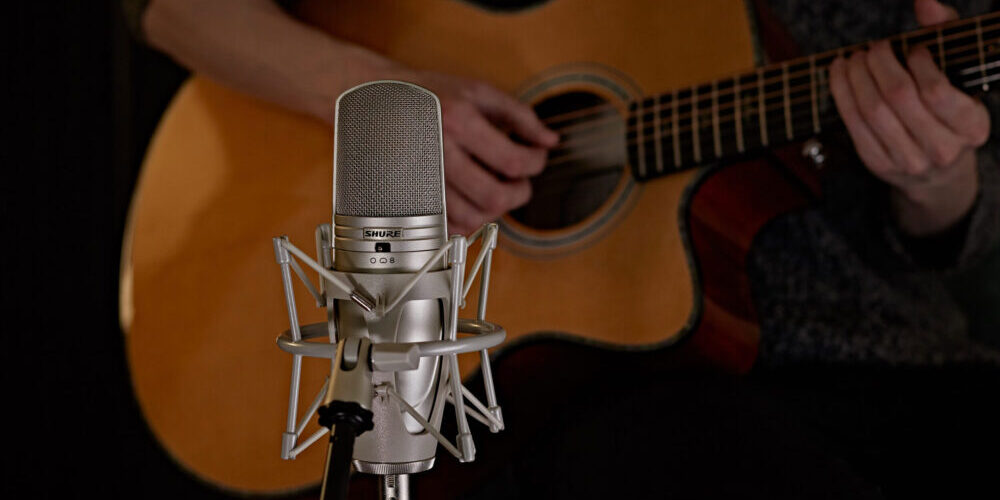












0 Comments